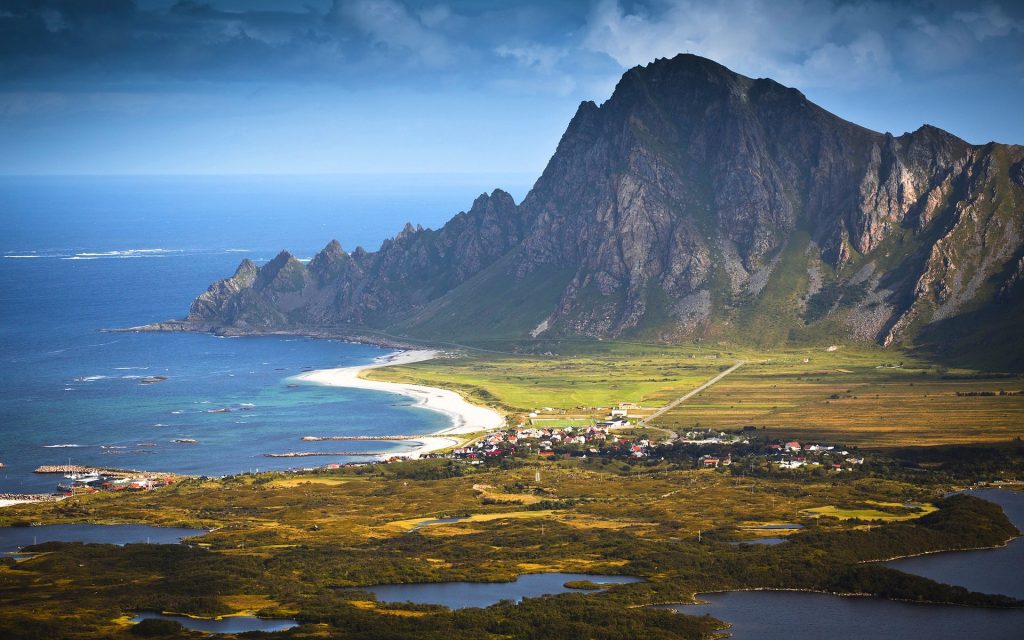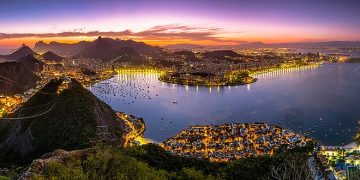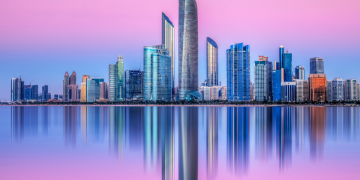Norway, a country in the western part of Scandinavia, is known for its winding coastline, magnificent natural scenery and rich Marine resources. The Norwegian coast is not only a geographical wonder, but also an important vehicle for economic, cultural and ecological diversity. This article will comprehensively explore the unique charm of the Norwegian coast from multiple dimensions, such as geographical location, topography, climate characteristics, Marine resources, fishery production, tourist attractions, socio-economic and cultural background, international comparison and connection, and future development trends and challenges.
Geographical location, landforms and climatic characteristics of the Norwegian coast
Norway’s coastline, some 21,000 kilometers long, is one of the longest in the world, with many twists and turns, forming countless beautiful fjords and natural harbours. These coastlines not only give Norway a unique natural landscape, but also provide unique conditions for the development of its Marine industry. Norway is located on the North Atlantic coast, bordered by Sweden to the east, Finland and Russia to the northeast, Denmark across the North Sea to the south, and the Norwegian Sea to the west. Its territory is long and narrow in the north and south, and the terrain is complex and diverse, with plateaus, mountains and glaciers occupying most of the land area, accounting for more than two-thirds.
Norway is best known for its fjords, formed by glacial erosion, such as Songenfjord, Hartangerfjord, Geilangerfjord and Lysefjord, which are not only natural wonders, but also a paradise for tourist explorers. In addition, Norway also has a large number of islands, more than 150,000 offshore islands, these islands not only enrich the Norwegian coastline landscape, but also provide rich water resources for its fishing production.

In terms of climate, most of Norway has a temperate maritime climate, influenced by the North Atlantic Current, with mild and humid winters and pleasant summers. However, due to its location within the Arctic Circle, northern Norway has a cold climate with long and severe winters. This climate has a profound impact on Norway’s ecological environment and biodiversity, as well as providing unique natural conditions for Norway’s fishing and Marine industries.
Marine resources, fishery production and tourist attractions of the Norwegian coast
The Norwegian coast is rich in Marine resources, including rich fishing resources, mineral resources and renewable energy. Norway is the world’s second largest exporter of fish, aquaculture is dominated by salmon, the main fishing species including cod, mackerel, herring and so on. The Norwegian sea is one of the world’s famous fishing grounds, thanks to the strong North Atlantic current and rich nutrients, the water temperature here is moderate, a wide variety of organisms, providing unique conditions for fishing production.
Fishing is an important part of the Norwegian economy, and Norwegian fishermen use advanced fishing techniques and equipment to catch a variety of fish and seafood in the vast ocean. In addition, Norway has actively developed the aquaculture industry, which has improved the yield and quality of aquatic products through scientific management and advanced farming techniques. Norwegian aquatic products are not only popular in the domestic market, but also exported overseas, contributing a large amount of foreign exchange earnings to the Norwegian economy.
In addition to its rich Marine resources, the Norwegian coast is also home to a number of fascinating tourist attractions. From spectacular fjords to peaceful fishing towns, from mysterious underwater worlds to stunning polar landscapes, every part of the Norwegian coast has a unique charm. Visitors can take a cruise between the fjords and enjoy the magnificent views on both sides; You can also visit the fishing village town to experience the local fishing life and cultural traditions; You can also go deep into the underwater world to explore the rich Marine life resources. Norway is also one of the best places to see the Northern Lights, attracting millions of tourists each year to this natural wonder.
Social, economic and cultural context of the Norwegian coast
Norway is a highly developed modern industrial country and one of the richest countries in the world. Its economy is largely dependent on natural resources such as oil, gas, fishing and forestry. Since the discovery of large quantities of offshore oil and gas in the 1970s, the oil and gas industry has dominated the Norwegian economy. Norway has a long and strong shipbuilding and shipping industry and is one of the fourth largest shipping countries in the world. In addition, Norway has made remarkable progress in the fields of science and technology, culture, education and health care, and has become a rich, safe and free country.
Socioculturally, Norway is a multi-ethnic country with a unique cultural tradition and historical background. Norwegians attach importance to environmental protection and sustainable development. The government actively promotes environmental protection policies and technological innovation, and is committed to reducing greenhouse gas emissions and protecting environmental resources. At the same time, Norway is also a highly democratic and equal country with a perfect social security system and public service system to provide people with a good living environment and welfare protection.
Comparison and connection of the Norwegian coast with other countries or regions
The Norwegian coast can be compared to other countries or regions from a number of angles. First of all, the geographical location of the Norwegian coast is located on the North Atlantic coast and many European countries across the sea, which makes Norway has unique advantages in international trade and shipping. Secondly, in terms of Marine resources, Norway has rich fishery resources and mineral resources, which provide strong support for its economic development. In contrast, some other coastal countries may face problems such as resource depletion or environmental pollution, while Norway has maintained the stability and prosperity of Marine resources through scientific management and sustainable development model.
The Norwegian coast has also established close ties and cooperation with other countries or regions. For example, Norway maintains close economic and cultural exchanges with its Nordic neighbors Sweden, Finland and Denmark. At the same time, Norway is also one of the important partners of the EU, although it is not a member of the EU, it actively participates in EU affairs and maintains good cooperative relations with EU member states. In addition, Norway also maintains close trade and investment relations with the United States, Canada and other Western countries, which provides a broad market and opportunities for its economic development.

Future trends and challenges for the Norwegian coast
Looking to the future, the Norwegian coast will face a number of trends and challenges. First of all, with the intensification of global climate change, the ecological environment of the Norwegian coast will face greater pressure and challenges. Climate change phenomena such as rising sea levels and melting glaciers will have a profound impact on Norway’s Marine ecosystem, requiring the government and all sectors of society to work together to strengthen environmental protection and combat climate change.
As international competition intensifies, the economic development of the Norwegian coast will also face new challenges and opportunities. On the one hand, Norway needs to continue to strengthen scientific and technological innovation and industrial upgrading to improve economic competitiveness and sustainable development capacity; On the other hand, Norway also needs to actively explore the international market and strengthen economic and trade cooperation and exchanges with other countries and regions to cope with the uncertainty of the global economic situation.
The social development of the Norwegian coast will also face some challenges and problems. For example, with the aging of the population and the increase in the number of immigrants, Norway needs to strengthen the construction of social security and public service system to improve the quality of life and happiness of the people. At the same time, Norway also needs to actively cope with the pressure on resources and environment brought by population growth, strengthen urban planning and management to ensure sustainable urban development.
The Norwegian coast, with its unique geographical location, rich Marine resources, fascinating tourist attractions and profound social, economic and cultural background, has become a unique natural and human landscape in the world. However, in the face of future development trends and challenges, Norway needs to continue to strengthen environmental protection and sustainable development capabilities and actively respond to climate change and pressure on resources and the environment. At the same time, Norway also needs to strengthen scientific and technological innovation and industrial upgrading to improve economic competitiveness and sustainable development capacity; Finally, Norway also needs to strengthen the construction of social security and public service system, improve the quality of life and happiness of the people, and lay a solid foundation for the sustainable development of the Norwegian coast.





















